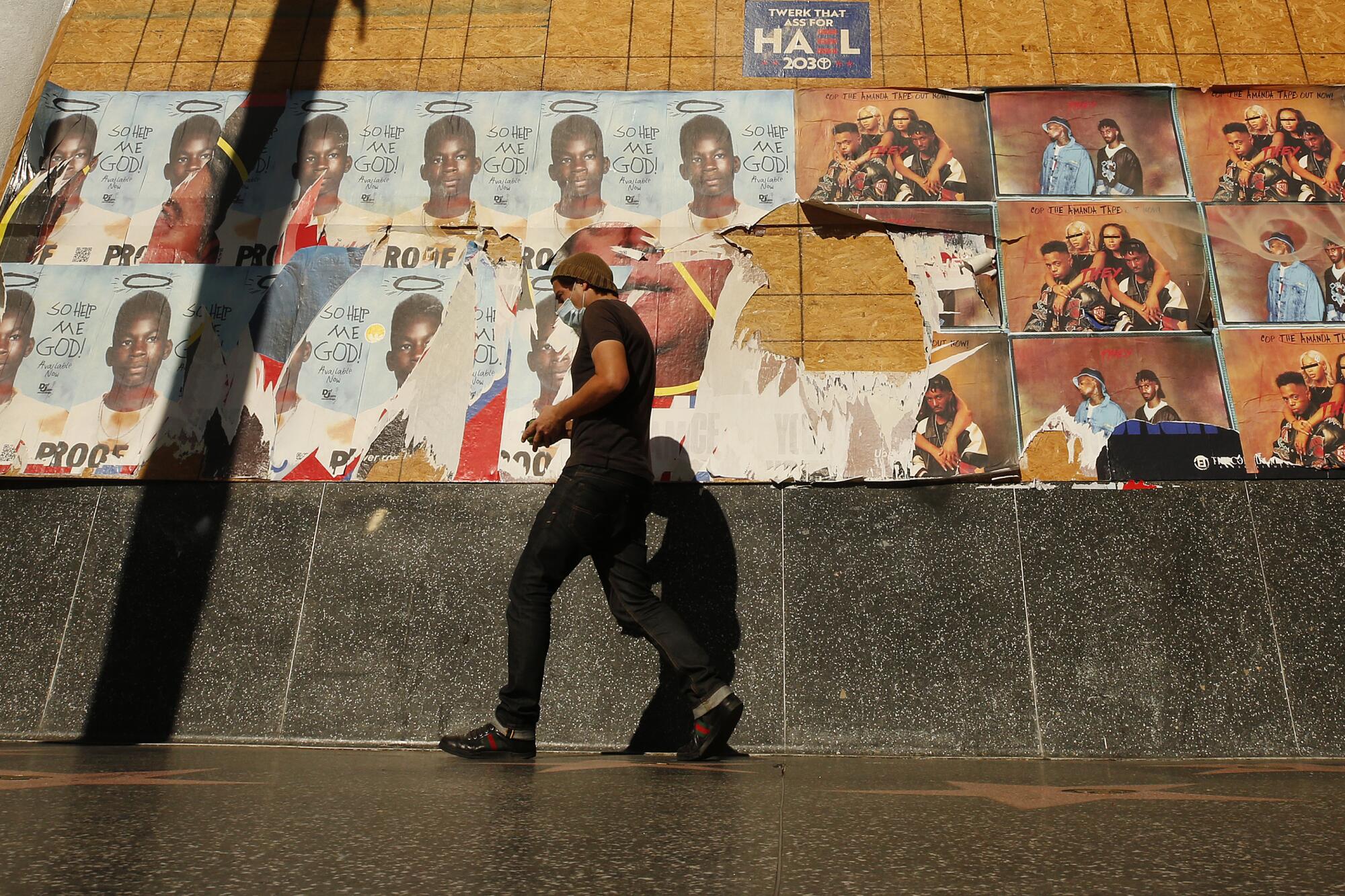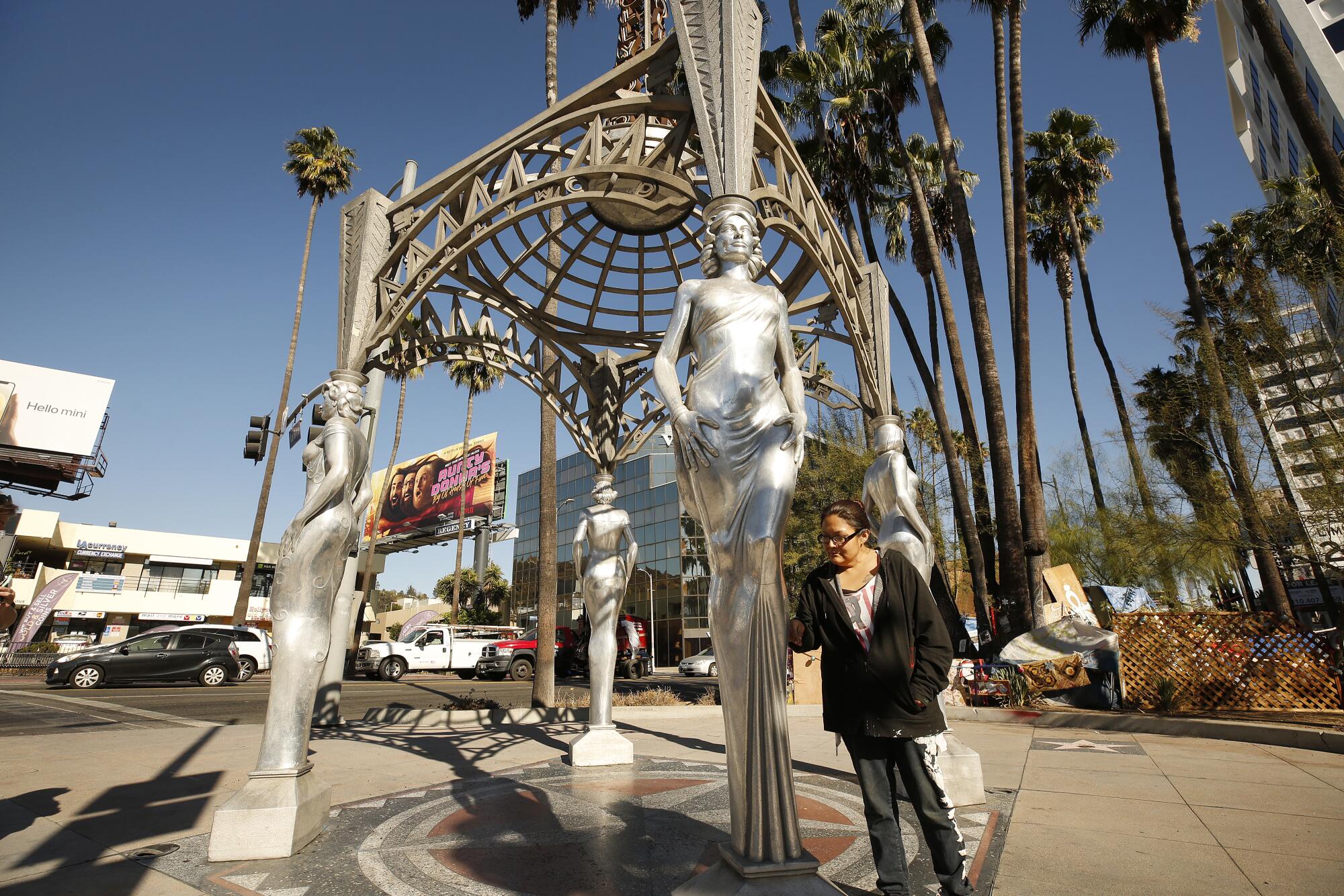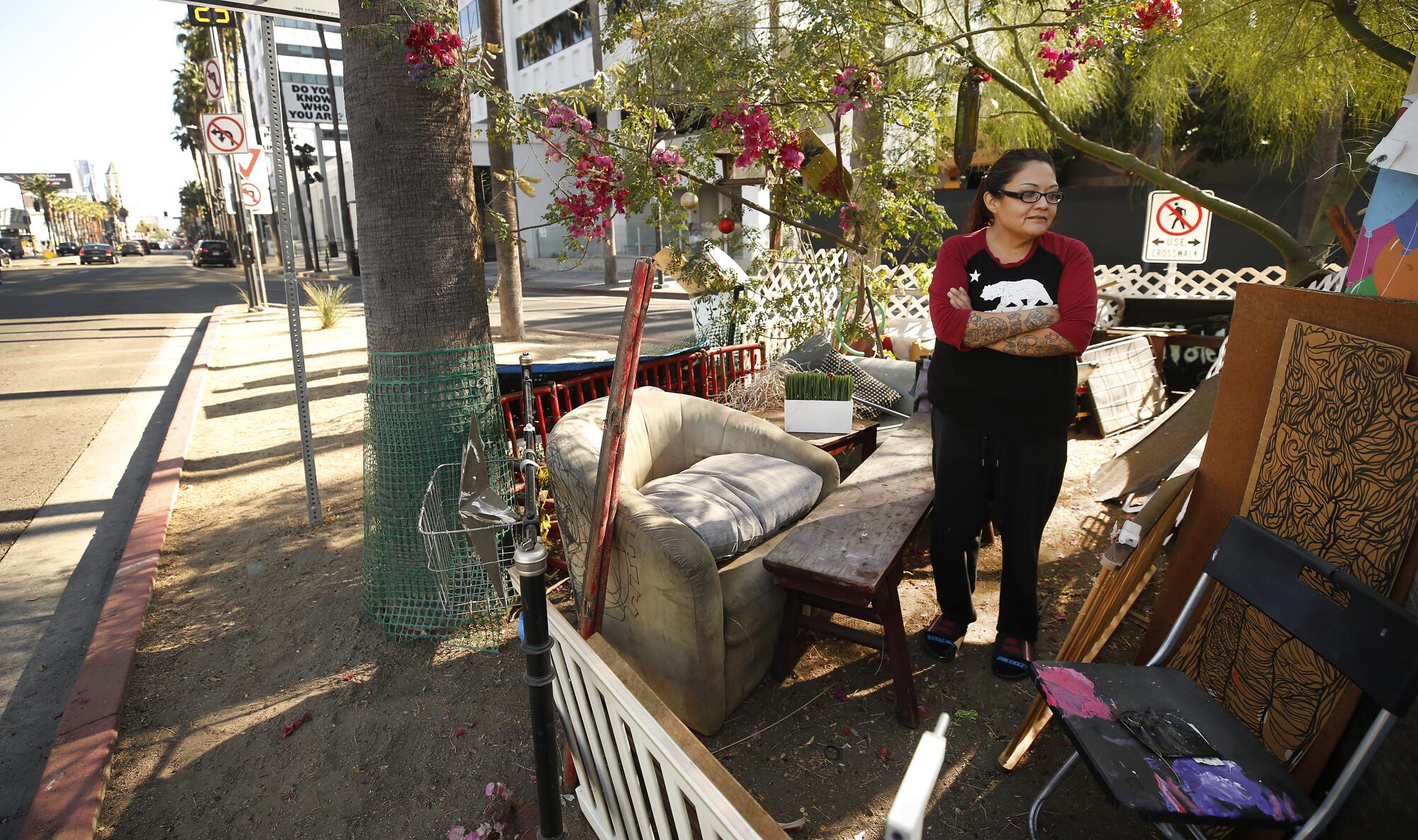
- Share via
Picture Hollywood Boulevard in the time before COVID, teeming with tourists looking down at the pink terrazzo stars on the Walk of Fame as costumed characters of all sorts, hoping to cadge tips, jostle one another to pose in their photos.
Picture it now, often eerily empty as the pandemic rages on. Ripley’s Believe it or Not! is boarded up and shut down. The dinosaur on the roof wears a mask. The Hollywood Wax Museum is shut. So is Madame Tussaud’s. TCL Chinese Theatre has barricaded off its famous forecourt handprints and footprints and is charging $5 a pop for a viewing, a few people at a time.
A few people is all there are most times on that part of the boulevard now.
The visitors who show up from out of town are taking a big risk to do so. And they are rare enough that if their eyes flit even for a second to those pink sidewalk stars, the few diehard characters still on hand swoop in fast, birds to birdseed.
On a recent afternoon, during a long stretch between scant opportunities, I watched two ratty Jokers sit on the steps of a mall nobody much seemed to be shopping in and lazily pass a joint back and forth and then over to a Chewbacca standing nearby.
I live near the boulevard. I keep track of it. I have watched it empty out in these pandemic months. But something caught my eye as I was driving along it a few weeks ago that seemed to me especially emblematic of this strange and unsettling time out of time.
It was right where the Hollywood Walk of Fame begins, on the west end of the boulevard at La Brea Avenue, next to the Four Ladies of Hollywood gazebo, held up by lithe, begowned statues of Dorothy Dandridge, Dolores del Rio, Anna May Wong and Mae West. Last year, someone stole Marilyn Monroe, holding down her windblown dress, from its top. She still hasn’t found her way back. Now the plaque identifying Dandridge is missing too. A cigarette stub is jammed between West’s silver lips.

And in the little triangle just behind this prominent gateway to the marble stars, tucked into a stand of palms, I was struck by what looked to me like a world’s end version of homesteading: an elaborate compound of outdoor living rooms and tents fenced off with found objects — the slatted sides of cribs, repurposed school banners, headboards from castaway beds, messages of protest painted on wood.
“Anarchy in the USA,” read one, which seemed to fit both the place and the moment.
Here was the tourist strip just about every first-timer to the city comes to see. And yes, even in ordinary times, they’re often nonplussed. The boulevard perpetually resists pressure to spiff itself up for outsiders. Its hard luck stories are often plain to see. But I kept thinking that if the usual visitors from around the world had kept arriving here in their usual numbers this year, somehow the powers that be — both civic and business — wouldn’t have tolerated this encampment’s existence.
I wanted to learn its story. It took me a few tries.
Several times, I stood at the fence and called out to no response as I ogled a scrawny tree just inside the perimeter festooned with Christmas ornaments and dried bougainvillea bouquets, a bird feeder hanging from one branch, an elegant Moroccan lantern with colored glass from another, a souvenir California license plate dangling from the trunk, with LOS ANGELES in yellow letters on a black background.

More than once, hoping to find someone home when I returned, I parked nearby and walked the boulevard to kill time.
I spotted security guards outside some of the big-box stores but only rarely encountered the police officers often visible when crowds are present along with those who wish to make money off them, from the hawkers practically forcing CDs into their hands to the buskers and the tour-bus barkers and the pickpockets.
I saw people lying across sidewalks so deserted they weren’t in anyone’s way. I saw some pushing shopping carts full of their belongings past storefronts covered over with plywood, plunging their arms into sidewalk trash bins and coming up empty.
I noted that a sidewalk hawker who usually dealt in shea butter and dried sage had expanded to face masks with logos — Black Lives Matter, Biden Harris, the Lakers.
I stopped to talk to salespeople in empty souvenir shops. One told me the staff at the store where he had worked for nearly 30 years had gone down from 25 people to three. “Never have I ever seen a time like this. Never,” said Pedro Consuelo of Souvenirs of Hollywood. “Very slow. Super dead. Look down the boulevard, nobody is coming.”
I met a young man hawking tours of movie stars’ homes in a dented open-topped van parked in front of his sidewalk stand, who said he earned nothing on the many days lately when there were no takers because he only got paid if he sold enough tickets for the operator to break even on the gas and the insurance and the driver. He told me that he lived nearby, around the corner, but I sensed from his reticence and from the dirt under his fingernails and on his clothes that it wasn’t in a place with a roof.
I ran into Dale Roberts of Cedar Rapids, Iowa, as he stopped to gape at Bill Cosby’s star on the boulevard. He said he had come to L.A. over Thanksgiving despite the virus risk because he had always wanted to see it. “I didn’t want to leave before I saw the stars,” he said.
But he and the friend he had traveled with had mostly just driven around in their rental car. “The good thing is that you can go to a big city like this now and it’s not crowded anywhere,” he said. “The bad thing is that unfortunately so much of it is closed.”
Each time I came back to the compound in the triangle, I noticed more things that intrigued me. The initials ICU spelled out in blue duct tape on some fencing made of green plastic netting. Paintings of flowers. A tidy strip of faux grass in front of the padlocked front gate.
I was working on my last column with Times photographer Al Seib, talking to people living on Hollywood’s streets about the hardships of all the indoor closures, when I brought him to the triangle and finally got lucky. We saw rustling in a tent. And out popped a friendly moon-faced woman in black-framed glasses, the right one missing a chunk of lens.
Soon Rochelle Begaye was telling her story, which was at least as surreal as the setting. She’d once come to visit Hollywood too, she said, only somehow she never left.
She had been living in this spot for three or four months, she said. She’d scavenged almost everything she’d used to build it. She had come to L.A. about four years ago, following a boyfriend. They’d camped awhile in the hills above the Hollywood Bowl, until one day they’d come back to the site they’d tried to keep hidden and found all their belongings gone.
They’d moved on to a tiny traffic island — much smaller than her current one — in the middle of a narrow Hollywood street lined with apartment buildings. She and the boyfriend had settled this spot together, she said, but he had started to abuse her by then and he left her a few days in.
It was the boyfriend, she told me, who first severed her from what had been a fairly predictable, stable life.
She’d grown up in New Mexico on the Navajo Nation and gone to college for a few years at Haskell Indian Nations University in Lawrence, Kan. It wasn’t for her though, and she’d wound up working in convenience stores. She was working at one in Harrah, Okla., four years ago, living in an apartment, driving a car she owned, when she took off to North Dakota to join the protest against the proposed Dakota Access Pipeline at the Standing Rock Sioux Reservation.
She became Facebook friends, she said, with the guy who would become the boyfriend, a veteran protester. After Standing Rock, she crossed the country to camp with him near the White House.
What they were protesting was interesting. It had to do with government control of our minds. She told me about sensors we breathe in that can control our bodies and our thoughts, about how tech is “making us dumber and killing us,” about how sometimes you think you’re hearing your own inner voice but it’s really someone else’s.
She said she’d been diagnosed last year with schizophrenia and bipolar disorder and Parkinson’s disease but had lost the pills she was supposed to take along the way. And anyway, they made her feel lousy.
I asked her about tents I’d seen pressed up against her fence, on the side closest to the statues. She said she didn’t know the people. They’d shown up a few days earlier. She didn’t like their trash or their version of art: big dollar signs scrawled in chalk on the palm trunks. (They were no joke. When I asked if I could talk to these neighbors, they told me no cash, no words.)
Begaye, 43, has no friends in Hollywood, she told me. She keeps to herself. She is out there all alone on a boulevard so lonely that some nights she feels all alone in the world.
I asked her about what looked to be a faded Virgin of Guadalupe on the cover of one of her tents. She said I was seeing the back of it. The front was on the inside so that she could see it when she needed it.
“I started painting it to make me feel better, to protect me. It’s my safe space” she said. And I understood.
In this moment, in this time out of time, we all find comfort where we can, even in the wilds of pandemic Hollywood Boulevard.
More to Read
Sign up for Essential California
The most important California stories and recommendations in your inbox every morning.
You may occasionally receive promotional content from the Los Angeles Times.











